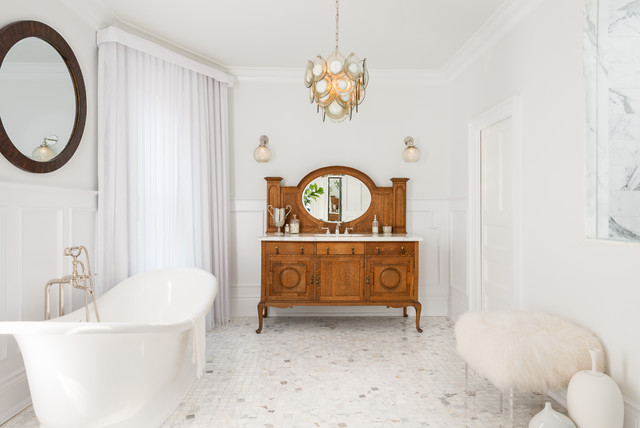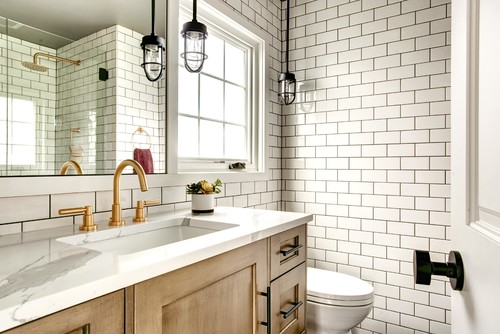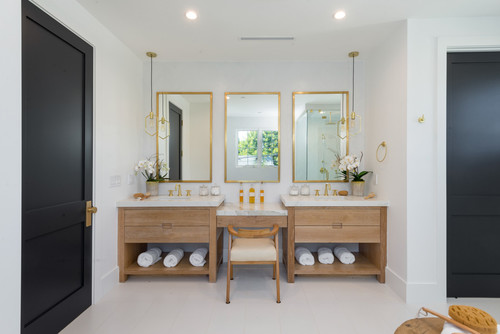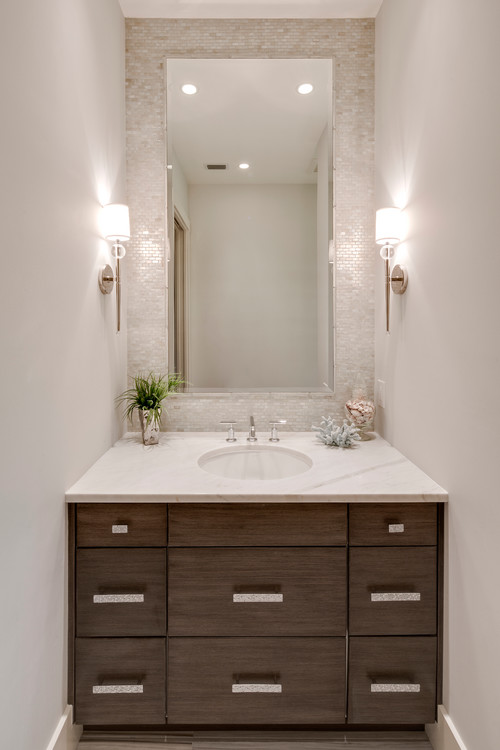
mikulas1/iStock
If you’re in the midst of a master bath or powder room remodel, a bathroom vanity is a great option to consider. The beauty of this cabinet, which holds the sink, is that it can provide storage for all, or most, of the everyday products, accessories, and cleaning supplies you need in the bathroom. It’s much more functional than, say, a pedestal sink that offers zero shelf space.
“The extra storage from the built-in drawers and shelving is one of the key benefits of a bathroom vanity—and the fact that it’s a piece of furniture that can dress up your bathroom’s look,” explains Amy Bly, a home expert with Great Impressions Home Staging/Interiors in Montville, NJ.
While the rest of your bathroom decor might be streamlined, the powder room is the place to take a design risk. That could easily start with a statement-making bathroom vanity, with updated faucets and a dazzling sink finish.
Here’s what you need to know about bathroom vanities, including sizing, price, and the wide range of styles.
How much space do you need for a bathroom vanity?
The general rule when it comes to sizing for a bathroom vanity is to allow 36 inches per sink.
“Anything less than this, and you won’t have much space around the bathroom sink and countertop edges for toiletries,” explains Sara Chiarilli, an interior designer with Artful Conceptions in Tampa, FL.
If you are dealing with almost zero space, narrow or corner vanities are available, like the especially slim one installed by decorator Darla DeMorrow of HeartWork Organizing in Wayne, PA.
“It’s just 15 inches wide, but it still offers storage,” she says. As to whether your vanity’s countertops should extend from wall to wall, the answer varies.
“They don’t have to reach each side of the bathroom, but I like a look that maximizes counter space and has no gaps for things to fall into,” says Bly.
Assess your vanity and sink style
The style of bathroom vanity you choose should match the overall aesthetic of your home, but don’t be afraid to shake it up and go for a more faddish look, especially in a guest bathroom. So what’s all the rage these days?
“The trends seem to be leaning toward clean lines, mid- or dark-toned rustic wood vanity cabinets, or a one-piece integrated acrylic or ceramic sink and countertop,” Bly says. White marble and quartz counters are also still popular, she adds.
“Soft gold or bronze, or brushed gold hardware, is starting to replace the ubiquitous chrome faucets that have been popular for many years now,” she says.
If you are committed to keeping a more consistent vibe in your home, bathroom vanities come in many different styles. You can stick with a standard painted wooden vanity with cabinet doors (like the ones you’ll find at your local home improvement store) or go for a more modern bathroom vanity, with a high-gloss countertop and pullout drawers.
A great way to incorporate vintage decor is to find a custom vanity built from an old dresser (like the one below). You may also want your sink and faucet finish to match those of the shower.

Cost of a bathroom vanity
As with most built-in bathroom cabinets and furniture, you get what you pay for—the more customized the vanity, the more expensive it will be. You can pay as little as $100 for a 24-inch-wide vanity and up to $3,000 for a 60-inch one from a home improvement store like Lowe’s. But the average cost of a mass-produced single-sink bathroom vanity is between $200 to $800, with most custom-made vanities running between $500 and $2,800, according to costhelper.com.
Although you may be tempted to go the bargain route with your bathroom vanity, you’ll want to watch out for cheap materials, says Chiarilli. Skip any vanity made from particle board or laminate instead of solid wood.
“Over time, the finish will peel off the cabinet,” she says.
When it comes to cabinet installation, it costs around $100 to $300 for a handyman or contractor to install a stock vanity. Semicustom or custom vanities can cost anywhere from $200 to $1,000 or more to install, depending on the complexity of the project, according to costhelper.com.
Fancy sinks, pricey faucets, updated cabinet pulls, or a new bathroom counter surround will also up the price of your new vanity. And if you have to reconfigure your shower or tub to accommodate a new vanity, add another zero to the price.
Vanities are stylish, but pricier than pedestal sinks
Photo by Designs of the Interior
Most designers love a bathroom vanity for the storage it offers, but the convenience of added storage will cost you. If installing a bathroom vanity in every loo is beyond your reach, put your money in the master bathroom.
“It’s super important to have a great-looking, functional bathroom vanity in this space, both for everyday living and for resale value,” says Chiarilli.
It’s fine to put a pedestal sink in a half bathroom or other bathroom that’s not used for getting ready in the morning or sees little traffic.
Cabinet details make the difference in a vanity
Bathroom vanities offer many opportunities for customization, to suit your style or personal needs (you might want double sinks or an unusual faucet in yours).
“Some master vanities might include a sit-down area at the sink for applying makeup,” says Jamie Gold, a San Diego–based certified kitchen designer.
You might also see vanities with towers, tall cabinets, or rollout drawers for additional storage. Other amenities can include a built-in hamper, a charging station for phones, cubbies for rolled towels, and a pullout step stool.
The post What Is a Bathroom Vanity? Adding Style (and Storage Space) to Powder Rooms appeared first on Real Estate News & Insights | realtor.com®.





No comments:
Post a Comment